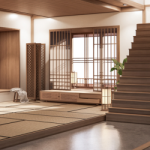In the realm of design, the difference between architecture and interior design lies in their primary focuses. While architecture concentrates on the overall structure, layout, and exterior of buildings, interior design hones in on the interior spaces, emphasizing functionality, aesthetics, and ambiance.
In this blog we will learn about the difference between architecture and interior designer, architect vs interior designer, architects and interior designers, and architecture vs interior design salary. So, continue reading this bog to get a better understanding of the difference between architecture and interior designer.
Table of content
What is Interior Design?
What is Architecture?
Difference Between Architect and Interior Designer
Skills Needed to Become an Interior Designer
Skills Needed to Become an Architect
Architecture and Interior Design | Which One to Consider
What is Interior Design?
Interior design is a comprehensive discipline that involves conceptualizing, planning, and executing designs to enhance and transform interior spaces. It revolves around creating harmonious, functional, and visually appealing environments within structures. Here’s a detailed breakdown:
- Space Planning: Interior designers strategically plan and organize spaces, considering traffic flow, functionality, and usability. This involves determining furniture placement, defining zones within a space, and optimizing layouts for efficiency.
- Aesthetics & Ambiance: They curate an atmosphere by choosing color schemes, materials, textures, and lighting that align with the intended mood and ambiance of the space. This includes selecting furnishings, accessories, and decor elements that complement the overall design.
- Client Collaboration: Interior designers work closely with clients to understand their preferences, requirements, and vision for the space. They interpret these needs into design concepts, ensuring the final result resonates with the client’s expectations.
- Technical Aspects: They possess technical knowledge about building codes, regulations, materials, and construction methods to execute designs effectively. They create detailed drawings, specifications, and plans that guide contractors and craftsmen during implementation.
- Problem Solving: Interior designers are adept at solving spatial challenges, addressing issues related to ergonomics, accessibility, and functionality. They find creative solutions to maximize space utilization and improve the overall user experience.
- Versatility in Projects: Their expertise spans diverse domains, including residential, commercial, hospitality, retail, and institutional projects. They tailor designs to meet the specific requirements of each space while considering the users’ needs and preferences.
In essence, interior design harmonizes creativity, technical knowledge, and functionality to craft spaces that not only visually impress but also cater to the practical needs and desires of the occupants.
What is Architecture?
Architecture is the art and science of designing and constructing structures, encompassing the planning, design, and creation of physical environments. It’s a multidisciplinary field that integrates creativity, technical expertise, and practical knowledge. Here’s a detailed breakdown:
- Designing Structures: Architects conceive and plan buildings, considering functionality, aesthetics, and sustainability. They create blueprints and design concepts that define the form, layout, and spatial organization of structures.
- Structural Integrity: Architects focus on the structural integrity of buildings, ensuring stability, durability, and safety. They collaborate with engineers to ensure that designs meet safety codes, building regulations, and standards.
- Site Analysis: Before designing, architects analyze sites, considering topography, climate, cultural context, and environmental factors. This informs decisions about orientation, materials, and construction methods.
- Conceptualization: They transform ideas and concepts into tangible designs. Architects utilize drawings, models, and digital tools to communicate their vision to clients, stakeholders, and construction teams.
- Project Management: Architects oversee the entire construction process, coordinating with contractors, engineers, and various stakeholders. They manage budgets, schedules, and ensure that the project aligns with the initial design.
- Specializations: Architects specialize in various areas such as residential, commercial, landscape, sustainable, or industrial architecture. Each specialization requires distinct expertise and considerations.
- Innovation & Sustainability: Architects embrace innovation, exploring new materials, technologies, and design approaches. They also emphasize sustainable practices, aiming for energy efficiency and eco-friendly construction methods.
In essence, architecture is about creating built environments that not only serve functional needs but also evoke emotions, inspire, and enrich the lives of those who inhabit or interact with the spaces. It encompasses a broad spectrum of activities, from creative design to practical implementation, shaping the world around us.
Difference Between Architect and Interior Designer
Architects and interior designers play distinct roles in the realm of design and construction:
Architects
- Scope: Architects focus on the design and planning of buildings, considering structural integrity, safety, and aesthetics for both exteriors and interiors.
- Education & Subjects: They undergo comprehensive education, including courses on architectural history, building sciences, structural engineering, and construction technology.
- Salary: Architects generally have higher average salaries compared to interior designers due to their broader scope and responsibility in managing the entire construction process.
Interior Designers
- Scope: Interior designers specialize in creating functional and aesthetically pleasing interior spaces. Their focus revolves around furnishings, layouts, color schemes, and ambiance within buildings.
- Education & Subjects: Their education involves course related to interior design, furniture design, materials, color theory, and interior architecture.
- Salary: Interior designers may have slightly lower average salaries than architects, given their narrower scope of work and specialization in interiors.
Difference Between Architecture and Interior Design:
Architecture primarily deals with the overall design and construction of buildings, including both exteriors and interiors, while interior design specifically focuses on the aesthetics, functionality, and ambiance of interior spaces. Architects are responsible for the structural integrity and functionality of buildings, whereas interior designers concentrate on creating appealing and functional interiors within these structures. Architecture is a broader field encompassing the entire building, while interior design focuses exclusively on internal spaces.
Skills Needed to Become an Interior Designer
Becoming an interior designer requires a blend of technical, creative, and interpersonal skills. Here are some key abilities needed:
- Creativity: Interior designers must have a strong sense of creativity to visualize and conceptualize unique designs that align with clients’ preferences while maintaining functionality.
- Spatial Awareness: Understanding spatial arrangements and proportions is crucial to optimize the use of available space efficiently.
- Attention to Detail: Being detail-oriented ensures precision in measurements, material selections, and overall design execution.
- Communication Skills: Effective communication with clients, vendors, and contractors is essential to convey ideas, negotiate, and manage projects effectively.
- Technical Proficiency: Proficiency in design software such as CAD (Computer-Aided Design) and other visualization tools is essential for creating and presenting design concepts.
- Color and Material Knowledge: A good understanding of color theory, textures, fabrics, and materials helps in creating cohesive and visually appealing designs.
- Problem-Solving Skills: Interior designers encounter challenges during projects. Having strong problem-solving abilities aids in finding creative solutions.
- Collaboration: Working in collaboration with architects, engineers, and contractors necessitates the ability to collaborate and integrate various aspects of design and construction.
Regarding architecture vs. interior design, while architects focus on the overall structure and exterior aspects of buildings, interior designers specialize in creating appealing, functional, and aesthetically pleasing interior spaces.
Skills Needed to Become an Architect
To become an architect, several essential skills are necessary:
- Design Creativity: Architects need a strong creative vision to conceptualize and design innovative structures that meet client needs while considering functionality and aesthetics.
- Technical Skills: Proficiency in architectural software, like CAD (Computer-Aided Design) and BIM (Building Information Modeling), is crucial for drafting and modeling architectural plans.
- Problem-Solving: Architects must resolve complex design challenges, considering structural integrity, safety, and environmental impact.
- Attention to Detail: Precision in measurements, calculations, and specifications is crucial to ensure accuracy in designs and blueprints.
- Communication: Clear communication with clients, contractors, and team members is essential to convey ideas, negotiate, and manage projects effectively.
- Knowledge of Building Codes: Understanding local building regulations, zoning laws, and safety codes is imperative for compliance and successful project completion.
- Project Management: Architectural projects involve coordination with various professionals. Efficient project management skills are crucial to oversee timelines, budgets, and resources.
Regarding the comparison between architects vs interior designers, architects primarily focus on the structural aspects, exteriors, and overall design of buildings.
Architecture and Interior Design | Which One to Consider
Choosing between architecture and interior design depends on personal interests and career aspirations.
Architecture
- Ideal for those fascinated by structural design, urban planning, and the overall built environment.
- Offers a comprehensive understanding of buildings, encompassing both exteriors and interiors.
- Involves creating designs that blend aesthetics with functionality and often requires a deeper understanding of engineering principles.
Interior Design
- Suited for individuals passionate about creating inviting, functional, and aesthetically pleasing interior spaces.
- Focuses on details within a structure, emphasizing furniture, color schemes, and ambiance.
- Provides a narrower scope, primarily centered on enhancing interiors rather than working on the entire architectural structure.
Ultimately, the choice between architecture and interior design relies on individual preferences regarding the scale of design involvement—whether one leans toward conceptualizing entire structures or specializing in enhancing internal spaces within those structures. Both fields offer diverse and fulfilling career paths, each with its unique set of challenges and opportunities.
Conclusion
When contemplating the choice between architecture and interior design, consider the scale of design involvement and personal interests. Architects delve into the comprehensive design of buildings, managing both exteriors and interiors, while interior designers focus on enhancing and beautifying internal spaces. Both architects & interior designers contribute uniquely to the aesthetics and functionality of built environments. Understanding the distinctions between these fields aids in selecting a career path aligned with one’s passion and aspirations in the dynamic realm of design and construction.


















